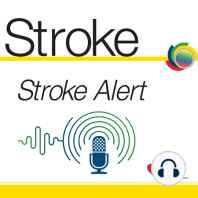17 min listen
Stroke Alert January 2023
FromStroke Alert
ratings:
Length:
45 minutes
Released:
Jan 19, 2023
Format:
Podcast episode
Description
On Episode 24 of the Stroke Alert Podcast, host Dr. Negar Asdaghi highlights two articles from the January 2023 issue of Stroke: “Covert Brain Infarction as a Risk Factor for Stroke Recurrence in Patients With Atrial Fibrillation” and “Subarachnoid Hemorrhage During Pregnancy and Puerperium.” She also interviews Dr. Georgios Tsivgoulis about his article “Clinical, Neuroimaging, and Genetic Markers in Cerebral Amyloid Angiopathy-Related Inflammation: A Systematic Review and Meta-Analysis.” Dr. Negar Asdaghi: Let's start with some questions. 1) When during pregnancy is an intracranial aneurysm at the highest risk of rupture? 2) What does the presence of covert brain infarcts mean in the setting of atrial fibrillation? 3) And, finally, how is the inflammatory form of cerebral amyloid angiopathy different from the classic CAA form, and why is it important to differentiate between the two? We'll be answering these questions and much more in today's podcast. We're covering the latest in cerebrovascular disorders, and this is the best in Stroke. Stay with us. Welcome back to another issue of the Stroke Alert Podcast. My name is Negar Asdaghi. I'm an Associate Professor of Neurology at the University of Miami Miller School of Medicine and your host for the monthly Stroke Alert Podcast. Together with my co-editors, Drs. Nastajjia Krementz and Eric Goldstein, here's our article selection for the month of January. Symptomatic intracerebral hemorrhage is a feared complication of reperfusion therapies in acute stroke, so there's a lot of interest in looking for predictors of development of this complication, especially when you're making decisions for pursuing endovascular therapy. For many years now, we've known about some of these predictors, such as presence of a large infarct core and high blood glucose levels. But in the recent years, other radiographic markers of tissue viability, such as a poor collateral status and unfavorable venous outflow profile, have been shown to be predictors of post-reperfusion hemorrhagic transformation. In this issue of the journal, we learn about another imaging marker that can potentially predict parenchymal hemorrhage occurrence post-endovascular therapy, which is high hypoperfusion intensity ratio, or HIR, as measured by perfusion imaging. What is HIR? It's a long name for a simple ratio that can easily be measured by dividing the volume of tissue with Tmax delay of over 10 seconds to the volume of tissue with Tmax delays of over 6 seconds. Simply put, Tmax 10 divided by Tmax 6. These volumes, as you know, are typically provided to us by almost all post-processing perfusion softwares, and so this ratio can be easily calculated in the acute setting. So, in this paper led by Dr. Tobias Faizy from University Medical Center in Hamburg and colleagues, we learned that higher hypoperfusion intensity ratios are strongly associated with parenchymal hemorrhage occurrence after endovascular therapy. So, in summary, HIR, that is a quantitative ratio, can be used as a marker to risk stratify patients that are undergoing endovascular therapy in terms of helping us predicting the risk of development of intracerebral hemorrhage after reperfusion therapies. In a separate study in this issue of the journal, we read a very interesting paper titled "Anti-Epileptic Drug Target Perturbation and Intracranial Aneurysm Risk." How are intracranial aneurysms even related to anti-epileptic drugs? Well, first of all, it's been known for a long time based on genome-wide association studies that there are multiple common genes that are associated with increased risk of intracranial aneurysm development. Now, some of the largest genetic studies to date have shown pleiotropy between genetic causes of development of intracranial aneurysms and genes encoding targets for anti-epileptic drugs. Now that's a fascinating finding because finding commonalities between these genes may help find new treatment targets for intracranial an
Released:
Jan 19, 2023
Format:
Podcast episode
Titles in the series (39)
Stroke Alert March 2021: Monthly summary & analysis of selected research published in the Stroke journal by Stroke Alert
